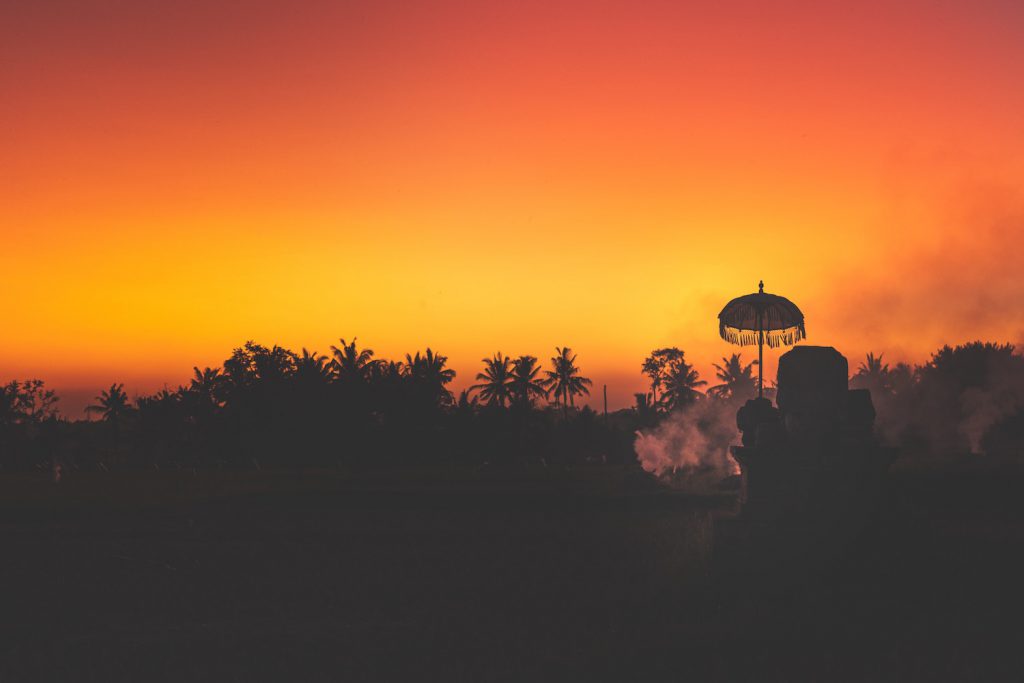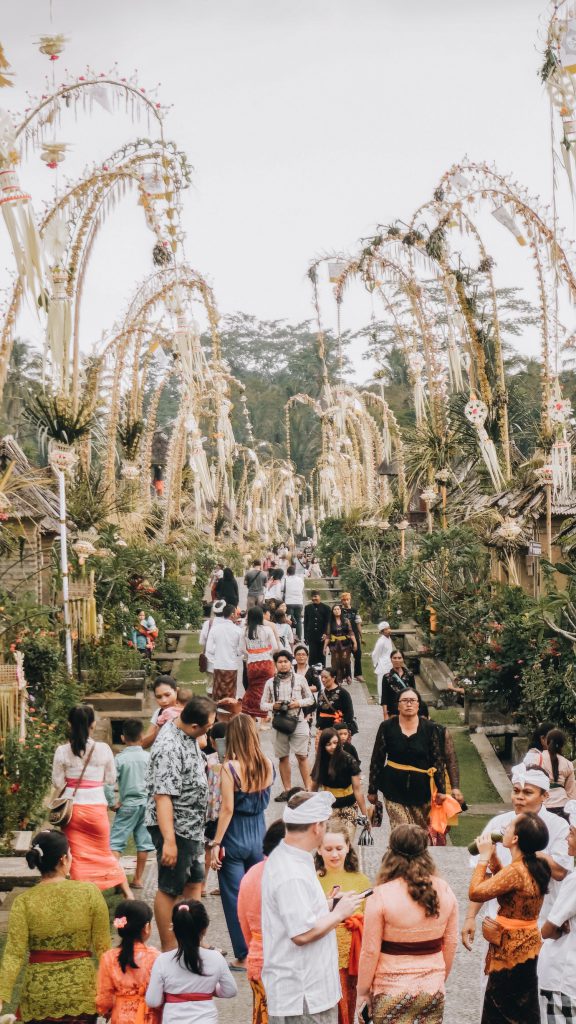Bite-sized Bali
Grown in Genocide, Consumed by Capitalism
by Anna Brachey

Bali, Indonesia—a paradise, so commonly known as “The Island of The Gods”—is an island full of religious expression, artists, flowers, dancers, and spirits. As much as any of these things, though, Bali is full of international tourists, fledgling yogis, foreign-owned businesses, and resorts built on mass, unmarked graves. This essay follows my experiences in Bali on a one-month study abroad trip focusing on cultural anthropology. Throughout my time on the island, my conversations and experiences with locals, my reading, and my study of Balinese art, history, and landscapes showed me a Bali that is not advertised in travel brochures. The island has historically been idealized and fetishized by the western gaze, but Bali’s past is complex and sometimes dark. Dutch colonialism, a 1960’s government sanctioned genocide, and the overarching power of western neoliberalism have shaped Bali alongside traditional Balinese spirituality, arts, and lifeways, creating a complex cultural mosaic of both collective trauma and creativity. Today’s Balinese struggle to commemorate erased violences while maintaining environmental and cultural autonomy in the face of mass tourism. In the face of these challenges, Bali is not ruined. Bali teems with art, biodiversity, and hopeful dissent, yet the shadows of colonial conquest, genocide, and neoliberal greed remain.
KEY WORDS: Bali, Tourism, Genocide, Environment
Sitting on a bench at Taman 65, I was overwhelmed by the sense that I had visited a post-traumatic Bali. Tropical mid-morning sunlight filled the courtyard, which looked quite like the courtyard of any other traditional Balinese home—an open greenspace surrounded by pavilions which housed extended family groups. But this courtyard was also a park and a memorial. The wall behind me read, in stark, white print, “FORGIVE BUT NEVER FORGET.” In front of me was Agung Alit, a man in his mid-sixties with long, black and white hair, crinkling eyes, and a room-lighting smile. He was bouncing with a manic energy while telling the story of government sanctioned violence in Bali during 1965.
I sat among classmates and friends, two weeks into a monthlong anthropological study abroad program. The goal of the program was to show students a Bali beyond the tourist gaze mesmerized by perfect beaches and performance dance. The objective was to help us understand the dynamic cultural moments, complex histories, and the influence of incessant tourism on an island culture rich in beautiful tradition despite post-colonial tragedies. The Bali I traveled through in May of 2019 is a colorful island teeming with art, biodiversity, and hopeful dissent shadowed by colonial conquest, genocide, and neoliberal greed.

Agung Alit told his story, and my classmates and I sipped coffees. Listening, I felt as though there was a “before” Bali and a censored, processed, packaged, “after” Bali, and that the turning point was a century of violence. Through my conversations with Balinese in the tourism industry and others deeply involved in political activism, I observed traces of past violence on an island often portrayed as an idyllic “paradise” in Western art, literature, and marketing campaigns. While some memories of violence are manifest and monumental, others have been systematically erased and hidden from the casual observer. In the 1965 Genocide, between half a million and three million people throughout Indonesia were killed (Byrne 1998). The New Order government—President Suharto’s political regime over Indonesia officially established in 1966—used intimidation and violence to create a culture of fear, silence, and submission in Bali (Byrne 1998). This intentional silencing left the island highly vulnerable to neocolonial foreign investment, neoliberalism, and mass tourism. Taman 65 is a park, a memorial, a space to remember the violence of the 1965 Genocide, a place to rebel against institutional obfuscation and erasure of collective memory.
I continually hear the word “stupidification” in activist circles in Bali. It’s a powerful word — capturing the idea that through the 1965 Genocide, subsequent censorship and falsification of history, the military government of Bali created a culture of ignorance. The first and most obvious example of stupidification was the elimination Balinese leftist intellectuals through mass killings. Victims of these killings numbered in the thousands. Government censorship and propaganda was used to subsequently and continuously assault Balinese collective memory through falsification of history and erasure of trauma. Both Agung Alit and Made Bayak, an esteemed Balinese painter and musician, speak on the military propaganda film shown annually to school children. This film is about the attempted coup and subsequent killings of Indonesian communists, supposed communists, and minority groups. Bayak relates that the film caused him, at one time, to believe that “those people deserved to die.”
The government also limits Balinese citizens by censoring and banning leftist literature. Agung tells a story in which an eager tourist sent him a book on Marxist Anthropology. The book was intercepted in the mail, leaving Agung to be questioned by the police. They interrogated him for any ties to the communist party, kept the book, and sent him away with a copy of The Pancasila (an official manifesto of Indonesia’s ruling philosophies—belief in God, civilized humanity, a unified Indonesia, democracy, and social justice). Through active and long-term censorship, the New Order government has created a Bali that does not remember the massacre of 1965 or the leftist ideologies of the 1940s and 1950s.
The Balinese were further silenced and oppressed by the re-domestication of Balinese women under the New Order. Ni Wayan Ariati, a Balinese woman and professor of History, explained to our class that women of the pre-1965 women’s movement, the Gerwani, were targeted in the genocide even though the movement was not officially tied to the communist party. The New Order’s treatment of Gerwani members is likely one reason for the general lack of women in today’s Balinese politics and political activism. According to Ariati, Gerwani members were accused of being communists, raped, and sometimes killed. Since the fall of the Gerwani, no women’s movement has taken its place.
Ariati was especially careful to explain that she was only teaching history and did not intend to start any type of women’s movement. She told our class that she, and all other Balinese, are mostly apolitical. While many of the women I met in Bali were artists, writers, and activists, many more were in roles of submission and servitude. Many more men seemed to know and speak English than women. Signs in Pelaga, a small village where we began our program, reminded women to be good and loyal wives, and to serve their husbands well. By dismantling Bali’s only women’s movement and encouraging the movement of women back into domesticated roles in the home, the New Order government reduced its potential political opposition by half the population.
Although the events of 1965 have shaped Bali, marks of the genocide are absent in its landscapes and monuments. Statues and museums commemorate the sites of the puputans—the act of mass ritual suicide in the face of an unwinnable battle—against Dutch colonial forces, and a monument marks the 2002 Bali Bombings in Kuta. Sites of importance in the 1965 Genocide remain unmarked. Even the mass graves of those killed in 1965 are unmarked and often located under new buildings. According to Agung, unmarked, mass graves are especially problematic in Bali, because the deceased cannot be excavated from the grave to be cremated according to Balinese customs.
In contrast, memorials to the Badung and Klungklung puputans were officially opened by the New Order government in the late 1970s and early 80s, as stories of the puputans became a widespread part of Bali’s collective memory and historical literature. The puputans were “important symbol(s) of the nationalist struggle against colonial oppression,” while the killings occurring under Suharto’s regime were ignored and unrecorded (Creese 2006). The New Order decision to shift public attention to acts of external, colonial violence against the Balinese was a clear strategic effort to obscure the violence that had occurred between Balinese under the New Order.
The 1965 Genocide also contributed to the creation of a vulnerable Bali through the production of a fear both intimate and external. Balinese speakers repeatedly communicated to our group that the murders of 1965 were committed by neighbors and friends. This personal, intimate violence left behind a legacy of distrust and fear within small communities. Sometimes this distrust and fear even occurs between friends and family members. Simultaneously, many Balinese acknowledge that perpetrators of the genocide generally killed as a result of overwhelming, collective fear of the military government. Agung posed the question: “Who wants to be a perpetrator?” Although violence was performed by neighbors, most people knew that the ultimate cause of the killings was the New Order government. The threat of violence came both from friends and from a seemingly omniscient government force which often overwhelmed Balinese citizens with anxieties and distrust.

In the decades of vulnerability following 1965, mass tourism and foreign investors came to dominate Bali’s economy. When Agung tells the story of 1965, he explains that after the tragedies, “Bali becomes tourism.” In a neocolonial reading of touristic development in Bali, the United States’ role in 1965 cannot be ignored. The U.S. government encouraged the genocide by making “kill lists,” producing propaganda, and covering the killings positively in the media. The United States made Indonesia a Cold War effort, aiding a government that was willing to massacre communists.
After the dissolution of the PKI—the Indonesian Communist Party—western-style neoliberalism dominated, and post-1965 Bali was rebuilt by the Indonesian government and foreign investors to be convenient, pleasant, and digestible to tourists (Lansing 1995). In the early 1970s, The World Bank collaborated with the New Order government to expand a tourist industry in which “international hotel chains were invited to go into partnership with investors (usually not Balinese)” (Lansing 1995). This plan resulted in most Balinese taking jobs in the service industry and very few seeing a significant increase in wealth or quality of life.
Santikarma (2005) explains that in the reproduction of a post-violence Bali, “the history of the 1940s, 1950s, and 1960s, when many Balinese were deeply involved in party politics and debates over issues like modernity, feudalism, land distribution, gender, and international capitalism, were swept aside with the broom of ‘tradition’,” to create a more tourist-friendly island. Similarly, Agung complained that the Balinese have been taught to be apolitical in order to keep the tourists happy and claimed that for most Balinese, there is a sense that “the capitalism is already in your body and your soul.” Significantly, Made Bayak’s artwork represents the same ideas that Agung discussed. In many of his paintings, skulls lie buried under hotels, restaurants, and resorts. These images are representative of real places actually built over mass graves, while also embodying the idea that the Bali of mass tourism was built on genocide. Agung and Made Bayak’s stories collectively depict a Bali that has been ransacked by genocide, actively dumbed-down by the government, and dominated by the primarily external forces of mass tourism, neoliberalism, and foreign investment.
The Balinese reaction to both Bali’s post-New Order dependence on mass tourism and dissatisfaction with the new national culture of tourism and capitalism are exemplified in a variety of art works through the last several decades. In particular, artistic reactions to the 2002 Bali Bombings were highly critical of tourist culture. Many international scholars interpreted the bombing as having very little to do with the Balinese; most believed that it was a part of a bigger, international struggle, or a warning to Americans or Australians (Dunbar-Hall 2007). The Balinese, however, tended to see the bombing as a punishment from God for disturbing the cosmic balance and exploiting the island for financial gain (Dunbar-Hall 2007).
As the Balinese began to question the merits of the tourism market, fewer and fewer tourists visited the island (fearing further terrorist attacks), creating an economic depression in Bali. So while the Balinese wondered whether or not they wanted tourists around, they realized that they now lived in a Bali that might need tourists for economic viability. Landras Syaelandra’s poem “At Tanah Lot Temple,” poignantly illustrates this sentiment, as the writer describes the sense of desecration and pollution that Balinese feel at the sacred site, which is located in view of President Donald Trump’s resort and golf course. Syaelandra writes, “Now we sit on what is left of the coral / reading about the glories of Balinese history / under an alien sun with / naked bodies sweating / wine and alcohol” (Cork 2000). This sentiment of loss and pollution is also manifested in the murals of Balinese street artist, Slinat, whose iconic paintings often depict Balinese women in traditional temple wear and gas masks. As Balinese famously incorporate art into almost everything they do, negative renderings of the tourist industry are particularly important.
Although the violence and politico-economic oppression of the New Order government and subsequent neocolonial mass tourism have had significantly negative effects on today’s Bali, there is hope for resistance in a generation of young activists and environmentalists on the island. For example, there is a large and growing island-wide social movement called Tolak Reklamasi (which translates to “Stop Reclamation”) whose members are opposed to the large-scale tourism development in Benoa Bay. Tolak members and supporters who are “fed up with the Balinese people’s passivity, enforced apoliticism and the government’s sales policy,” (Brauchler 2018) have successfully campaigned against tourism projects that would destroy the ecological and spiritual integrity of Benoa Bay. According to members of the Tolak movement, developing the bay would not only contribute to overdevelopment but also cause significant damage to water systems, mangrove populations, and aquatic ecosystems in an area that is officially protected as a conservation site. This movement’s ability to postpone (perhaps indefinitely) the development of the bay is a positive step toward regaining autonomy and forming a healthier relationship with tourism. Similarly, Agung and the other people at Taman 65 have made significant efforts and impacts in educating their communities about the 1965 Genocide. Projects like The Prison Songs book, album, and documentary in which Balinese activists recorded the songs and stories of the Balinese imprisoned during 1965, have and will continue to force Balinese communities to address the legacies of violence within villages.
Moving into the future of tourism in Bali, there is potential for sustainability in the increasing popularity of eco-tourism hotels and village homestays. Eco-tourism hotels and restaurants claim to be much more sustainable than the massive hotels that popped up in the 1980s, 1990s, and early 2000s. However, they are not always as “green” as they seem.

Businesses aim to green-wash their marketing strategies—advertising as sustainable and socially-responsible to draw in visitors while actually making very few changes. Doing so, eco-tourism resorts manufacture innocence for the tourist while encouraging the overwhelming onslaught of tourism, new construction, and subsequent environmental degradation.
How do well intentioned, conscious eco-tourists fit in to the consumption of Bali by tourism? How am I complicit in my own educational travels in Bali? Should we never travel again? As long as Global Northerners travel to the Global South, these questions will arise. They are not easy questions to answer, but important questions to ask. While eco-tourism clearly cannot fully erase the impacts of Bali’s booming travel industry, if employed earnestly, it could build a much brighter future for Bali. Organized homestays like JED, a village ecotourism network in Bali where my group stayed, have very little environmental impact and give local people more control over cultural tourism markets. Villages in networks like JED profit from tourism while maintaining village agency and traditional lifestyles. Efforts like the JED village ecotourism network, combined with practiced humility and responsibility in travelers, have potential to change the landscape of tourism in Bali for the better.
A series of violent episodes altered Bali’s culture and the collective spirit of the Balinese. The greatest and most traumatic violence are also the least remembered. The 1965 Genocide is not openly spoken about, even though its shadow will haunt Bali forever. The violence of 1965 and the mass government manipulation following the massacre resulted in a fragile Bali, one ripe for exploitation by external investors and large companies. Post-1965 Bali is built on mass graves, both literally and figuratively, and the mass tourism that rules the island today seems to be unsustainable, unwanted, and unshakable. In a state of mass touristic development, Balinese environment and society have suffered. Yet, despite all the violence, oppression, and erasure, there is potential for a more sustainable and autonomous Bali in movements and efforts like the Tolak Reklamasi, Taman 65, and sustainable eco-tourism.
References
Brauchler, B. (2018). Diverging ecologies on Bali. Sojourn: Journal of Social Issues in Southeast Asia, 33(2), 362-396.
Byrne, D. (1998). Traces of ’65: Sites and memories of the post-coup killings in Bali. Australian Humanities Review, (10). Retrieved from http://australianhumanitiesreview.org/1998/05/01/traces-of-65-sites-and-memories-of-the-post-coup-killings-in-bali/
Creese, H. (2006). A puputan tale: “The story of a pregnant woman.” Indonesia, (82), 1-37.
Cork, V., Trans. (2000). The morning after: Poems about Bali by Bali’s major poets. Darma.
Lansing, J.S. (1995). The Balinese. Harcourt Brace College Publishers.
Dunbar-Hall, P. (2007). “Apa salah baliku?” (‘What did my Bali do wrong?’): Popular music and the 2002 Bali bombings. Popular Music and Society, 30(4), 533–547.
Santikarma, D. (2005). Monument, document and mass grave: The politics of representing violence in Bali. In M.S. Zuruchen (Ed.), Beginning to remember the past in the Indonesian present (pp. 312-323). Singapore University Press.
Acknowledgements: I thank Sarah Hitchner, Pete Brosius, and Naia Bulan for teaching and learning with me in Bali, for reading and guiding my writing, and for encouraging exploration and joy in learning. I thank Wayan and Rus and all of the other wonderful, kind people I met in Bali.